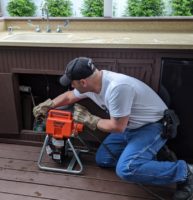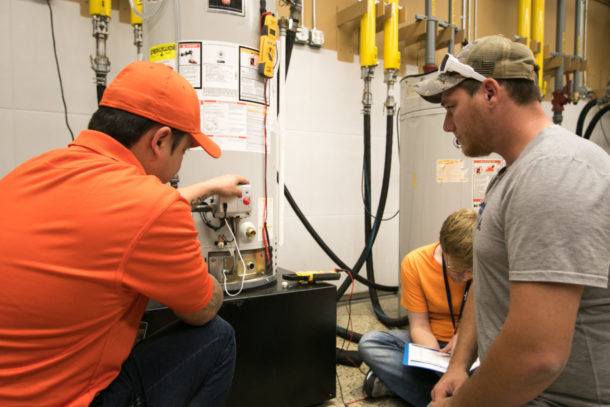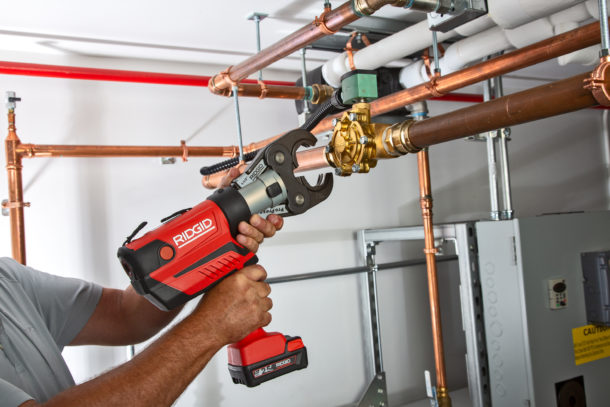Whether you are trying to fix a leaky faucet, install a new toilet, or tackle a larger bathroom renovation, the occasional plumping projects are a common part of home ownership. But how do you decide if you should don the DIY hat or bring in the professionals? Keep reading to find out! When to Read more
Whats New

Whether you are trying to fix a leaky faucet, install a new toilet, or tackle a larger bathroom renovation, the occasional plumping projects are a common part of home ownership. But how do you decide if you should don the DIY hat or bring in the professionals?
Keep reading to find out!

When to call in the experts
When it comes to new installations, especially those involving water supply lines and drainage systems, it is advisable to bring in professional plumbers. More advanced tasks like adding a new bathroom, installing a new dishwasher, or setting up an outdoor water feature are best left to the professionals.
Additionally, professional help is a must for extensive plumbing repairs such as fixing burst pipes, repairing sewer lines, or addressing water heater issues. These tasks involve intricate systems and potential risks, and attempting them without the necessary knowledge could worsen the problem.
Making the decision: DIY or professional plumbing
- Project complexity: While you might feel confident about fixing a leaky faucet, more complicated tasks like rerouting plumbing lines or installing a new toilet require specialized knowledge. If the project involves multiple components or if you are uncertain about the steps involved, it is wise to seek professional help.
- Budget and cost estimation: Even if you are skilled enough to tackle a project, you also need to assess the potential costs involved. This is where tools like a new construction plumbing cost estimator come into play. These tools factor in the cost of materials, labor, project complexity, and more to estimate the plumbing project’s final price. These insights can help you determine if handling the project yourself is more cost-effective or hiring professionals.
- Time and convenience: Time is another major factor you need to consider when making your decision. DIY projects can take a long time, especially if you are learning as you go. Professionals, on the other hand, can complete tasks efficiently, saving you precious time and sparing you from potential frustrations.
When to DIY
DIY can be a practical solution for minor leaks or dripping faucets. With some basic tools and patience, you can fix these issues without much trouble. Clogged drains are another common issue that DIY enthusiasts can often handle on their own. Using a plunger or a drain snake, you can clear out minor blockages.
The benefits of professional plumbing services
- Experience and expertise: Professional plumbers undergo rigorous training, possess in-depth knowledge of plumbing systems, and are well-versed in local building codes and regulations. For more complex projects like new installations or major repairs, their technical know-how ensures that the job is done correctly.
- Efficiency and time savings: Plumbing issues can disrupt your daily routine, and the longer they linger, the more inconvenience they cause. When you hire professionals, you are not just paying for their skills and expertise; you are paying for time and efficiency. Professionals can diagnose and resolve problems swiftly, minimizing disruptions and preventing potential water damage.
- Guarantees and warranties: Reputable plumbing companies offer guarantees and warranties on their work. The peace of mind that comes with knowing your plumbing work is backed by professionals can’t be overstated.
Wrapping up
The decision between DIY plumbing and professional plumbing services isn’t a one-size-fits-all proposition. Simple tasks might be more suitable for a DIY approach, whereas complex projects demand the expertise and assurance that can only come with professionals. You need to carefully assess your skill level, the complexity of the project, the time you can dedicate to the project, and your budget before you arrive at a decision.
Whether you are tightening a bolt or tackling a complete plumbing overhaul, remember that your ultimate goal is to maintain the functionality and integrity of your home’s plumbing system!

When you want to start a plumbing business, you’ll naturally want it to be successful. The problem is figuring out how to do that. You’ll already have a few ideas, but that doesn’t mean you’ll know everything you need. Instead, you could have to find out a few other things. That’s where a few practical Read more
When you want to start a plumbing business, you’ll naturally want it to be successful. The problem is figuring out how to do that. You’ll already have a few ideas, but that doesn’t mean you’ll know everything you need.
Instead, you could have to find out a few other things. That’s where a few practical tips come into play. By paying some attention to them and putting the work into it, you’ll start a successful plumbing business and see more growth than you would’ve thought.

Start A Successful Plumbing Business: 3 Practical Tips
1. Take Care Of Legalities
While legalities won’t play a significant role in your success, they’re one of the first steps to take if you want to start a plumbing business. Without it, you mightn’t be able to actually run your business. You’ll have to take care of this from as early as possible if you want to run any kind of company.
You should get clearance from authorities to actually run your company. You could even need to get certain licenses and permits before you can start doing anything. Once you do, you can start concentrating on everything else.
2. Get The Right Equipment
You’ll need a certain amount of equipment to run your plumbing business. Make sure you get these from the start so you don’t run into any hiccups in time. While this means spending a bit of money on them, it’ll be more than worth it once you start working with clients.
There’ll be quite a bit to pick up, and even a custom tool kit could be more than enough to help with this. After you’ve gotten everything you need, you’ll be in a much better position to actually service your clients and work on projects. It’s one of the first things you should do.
3. Generate Leads
Leads are one of the most important things to generate when you want to start a successful plumbing business. These are the people who’ll be interested in your services, and you’ll need to get as many of them as possible. The more of them you have, the more likely it is you’ll start making money.
The trick is to turn these leads into sales. Using the right sales and marketing strategies is integral to this. By focusing on local leads and getting customer referrals, you can make this much easier for yourself. Try to develop long-lasting relationships with them, and you’ll have no problem bringing in more sales in time.
Start A Successful Plumbing Business: Wrapping Up
Trying to start a successful plumbing business can be difficult, especially if it’s your first time running a company. You’ll have a few general ideas about how you can do this, but that doesn’t mean you’ll know everything you need.
You might need to put a little more time and effort into it, which is where a few practical tips to start a plumbing business come in. Once you put the work into the right areas, you shouldn’t have a problem seeing success long-term.

Approximately one in five small businesses close every year, and the most common reason for this is the inability to scale, grow, and compete in the market. There are specific strategies and tools that you need to employ to keep your business running. This also applies to a plumbing business, which requires long-term investment and Read more
Approximately one in five small businesses close every year, and the most common reason for this is the inability to scale, grow, and compete in the market. There are specific strategies and tools that you need to employ to keep your business running. This also applies to a plumbing business, which requires long-term investment and consistent hard work to grow.
Growing a plumbing business will help you increase your profits tenfold if you expand it according to suit industry and home changes. In this article, we’ll discuss three effective strategies and tools that can help you revolutionize your plumbing business.
1. Leverage a Plumber Answering Service
A plumbing business primarily deals with customers who have an immediate need, whether a frozen pipe, a clogged drain, or anything else that needs a plumbing solution. Your phone is going to ring 24/7. That means you’ll lose customers if your phone goes to voicemail, has long hold times, or can’t assist your clients immediately. That’s where a plumber answering service comes to the rescue.
These services bridge the gap between your business and customers and can attend calls professionally, swiftly, and around the clock. When calling a plumbing business, people prefer that their calls don’t have a long hold time and they can talk to an actual person and not hear jargon that will waste their time. A plumber answering service can follow the exact call protocol and scripts you give them to give the customers an experience as pleasant as possible.
In addition, with the call answering outsourced, you can significantly reduce the chaos in your plumbing office and have the management focus on other administrative tasks and plumbing assignments that come your company’s way. It’s an effective tool to keep your plumbing customer base from entering your competition’s hands.

2. Optimize Your Website
While traditional plumbing has existed for ages, it must evolve to stay relevant. Unlike the past, where plumbers solely relied on word of mouth to get business and clients, more consumers now use the internet to search for a plumbing professional, especially since the COVID-19 pandemic. A search-engine-optimized, interactive, and easy-to-navigate website is now just as essential to expand your customer base.
You don’t need a coding expert to prepare your website, nor must it be very dense in information. You need to ensure the user has an uncomplicated navigating experience. The website should have easy-to-find information about your plumbing services and how much they will cost your customers. Your contact information and a call to action should be among the first things people see when they open your website.
Keep the design simple yet attractive, and avoid stuffing the pages unnecessarily. You can always use WordPress templates if you need them. Adding testimonials from your previous clients would also be a good idea. That way, prospective customers can know you’re reliable for plumbing.
3. Diversify Your Services
Speaking of your plumbing services, you might have started your business with just one or two, such as repairs. However, expanding your service pool is essential if you wish to grow your business and its reach. That can include water heater installation, sewer line repair, and bathroom remodeling, which can broaden your clientele significantly.
Endnote
To wrap up, the world of plumbing is now becoming very dynamic and advanced, with the newest technologies making their way through. Customers now expect efficient and seamless plumbing service where they don’t have to deal with long waits or unreliable plumbers. Hence, it’s crucial to refurbish your website, have compelling call answering 24/7, and offer various services. That way, your plumbing services will stand out from its competitors, and you’ll be able to foster long-term relationships with your clients while expanding your business.
Within the plumbing industry, there are so many different products and materials that are critical to carrying out the tasks needed. They say a shoddy workman blames their tools but, in fact, the better the tools, the better the work they can carry out. So how can plumbers check that their equipment is of a Read more
Within the plumbing industry, there are so many different products and materials that are critical to carrying out the tasks needed. They say a shoddy workman blames their tools but, in fact, the better the tools, the better the work they can carry out. So how can plumbers check that their equipment is of a high quality and how can they maintain it?
Examine Build Quality
One of the best approaches is very simply to inspect the build quality of the equipment. While many organizations will have very strict welding and manufacturing capabilities you should inspect the build quality to ensure there is attention to detail and solid construction. Any equipment that’s poorly built is more likely to wear out.
Any beginner plumber needs to remember that the more you invest at the outset in terms of quality equipment, the better the results will be. Plumbing tools are subjected to tough conditions, so they must withstand wear and tear. Equipment made from materials that are built to handle the demands of plumbing work is about the overall build quality that you should examine and, more importantly, examine prior to purchasing.

Researching Trusted Brands
If there is one problem many tradespeople make at the very outset of their journey, it’s that they opt for cheaper items rather than trusted ones. It’s obvious as to why, but when we go for brands with a history of producing reliable equipment, this will result in better products. The plumbing industry has a number of top plumbing brands such as American Standard, but you also need to ensure that you have an understanding of how these brands will translate to the right end products.
When looking for equipment, you should see if there’s any relevant approvals or certifications from industry standards organizations. In the plumbing industry, standards such as the Uniform Plumbing Code (UPC) are in place to govern the installation and inspection of plumbing systems to promote the public’s health and safety welfare. Additionally, the International Plumbing Code provides requirements for plumbing systems in a wide variety of buildings, including commercial and residential. Plumbing providers that have approvals from these industry standards will naturally indicate the equipment meets specific safety and quality standards.
Evaluate the Warranty and Support
Any equipment will come with guarantees or warranties. Manufacturers’ willingness to stand behind their products will always be a testament to their quality. A very simple thing but these warranties will give you a far better understanding of the company and what they do to provide great customer support. The customer support part is always another key area to understand in case of any potential problems or if you have any questions.
Checking for Compatibility
We all need to ensure that when we are conducting specialized tasks, we need the appropriate equipment. Specialized tools are going to improve efficiency and bring about more accurate results. For example, if the equipment is part of a larger plumbing system, we need to make sure that it’s not just compatible with those specialized systems but is also able to work in tandem with our existing tools and systems.
Testing the Equipment
If possible, we should test the equipment prior to purchasing. We need to have an understanding as to whether a tool like a pipe cutter is able to cut accurately and smoothly, which can maximize safety and precision. Equipment is subject to tough conditions, so it has to withstand wear and tear. We need to ensure the equipment is made from materials that can handle the demands of the job in question. Equipment that requires precise adjustments or measurements should provide easy and accurate markings. Ensuring that we test for functionality, but also look for ergonomic designs, can make life easier for us.
Plumbing is a labor-intensive practice, and therefore, we need to reduce fatigue during long jobs. An understanding of how user-friendly that equipment is will naturally have an impact on its cost, but we must give great consideration as to whether it’s a worthwhile investment. Lower prices may indicate lower quality, but excessively high prices don’t always guarantee great quality either. We should always seek recommendations from plumbing suppliers or stores who will have insights into what is popular amongst professionals, but is actually built for purpose.
The task of checking for the right equipment and ensuring you have the tools you need for a successful job is about the overall recommendations made by industry professionals, but it’s important to trust your instincts as well. The right equipment should inspire confidence in you and feel reliable from the moment you handle it.

Hardwood floors hold a regal and timeless charm, offering a delicate balance of elegance and practicality to the interior of your living spaces. However, you must put considerable effort into maintaining your hardwood floors’ natural warmth and personality. Exposure to moisture can instigate unwelcome changes to the structural integrity of your flooring and mold growth Read more
Hardwood floors hold a regal and timeless charm, offering a delicate balance of elegance and practicality to the interior of your living spaces. However, you must put considerable effort into maintaining your hardwood floors’ natural warmth and personality.
Exposure to moisture can instigate unwelcome changes to the structural integrity of your flooring and mold growth in the quiet corners of your home. Mold infestation threatens not only the integrity and splendor of these cherished floors but also your family’s health in terms of respiratory issues and allergies. Continue reading this article to learn about the latest advancements in plumbing systems to protect your hardwood floors against water damage.
How Does Water Damage Hardwood Floors
Here is how water affects your beautiful wooden floors
1. Mold
The most significant limitation of hardwood is its susceptibility to mold formation. Faulty pipes can lead to small leaks that can progress into water bursts if not timely repaired. This can cause leaks to accumulate under your hardwood to form mold in floor, accompanied by staining of the wood surface and a putrid smell. Mold can pose serious health hazards to people living in the house, relating to respiratory issues and skin and eye allergies.
2. Swelling and Cupping of Planks
Prolonged water damage can cause water to seep into the sub-flooring. The wooden planks start to absorb the water and present as swollen planks that rise at the edges and an uneven surface. Alternatively, the planks can warp and bow downwards, dripping water down the subflooring.
3. Soft Boards
Soft wooden flooring is the most evident and tell-tale sign of prolonged and extensive water damage. They can cause severe damage to the structural integrity of your floor and lead to slipping hazards. Soft boards signify the planks of your hardwood are rotten and need immediate replacement. They also indicate that the damage has spread to other areas of your house.
Plumbing Upgrades to Prevent Leakage and Mold
If you are a homeowner planning a renovation, it is essential to consider the latest, enhanced plumbing systems to ensure your hardwood floors are maintained in impeccable condition.
1. Leak Detection Technology
Modern leak-detecting sensors give early warnings against potential leaks. They work by monitoring the water flow through the pipelines and identifying disruptions in flow. The sensor automatically cuts off the water supply to the household through a main valve and prevents leakage until the issue has been resolved. Conveniently, these sensors are customizable, so you can adjust the settings according to your daily water usage, and the system will automatically detect excessive water flow that accompanies leakage.
2. Plumbing Insulation
Effective plumbing insulation around all the pipes in your household is a worthwhile investment. Plumbing insulations are installed to limit condensation on pipe surfaces, which can lead to corrosion and, ultimately, leaks and pipe bursts. Additionally, they provide a noise-cancellation effect and regulate temperatures, effectively reducing your bills in the cold seasons. Insulation can be achieved through various means available in the market, including:
- Cheap polyethylene foams with pre-cut slits that can conveniently slide over your pipes
- Versatile rubber insulation that is easy to install and can be used both indoors and outdoors
- Fiberglass insulation which is effective in preventing pipe bursts during the cold winters
- Mineral wool, with its noise-cancellation and fire-resistant properties
3. Anti-Flooding Mechanisms
Backflow occurs when the dirty municipal water mixes with clean water in your plumbing system. It mostly occurs when you don’t adequately safeguard your plumbing system with backflow prevention devices, so the municipal water is siphoned into your plumbing system when there is a drop in the city’s water pressure.
You can prevent backflow by using sump pump devices and vacuum breakers that break the suction vacuum formed by a backflow situation. Installation of these devices will ward off the risk of your house flooding with sewage water and maintain the integrity of your plumbing system and hardwood floors.
Endnote
Maintenance of your cherished hardwood floorings and an effective plumbing system go hand in hand. It is crucial to equip yourself with advanced plumbing devices to guard your wooden floors against mold infestations and preserve their classy look while prioritizing your family’s health and house’s hygiene.
